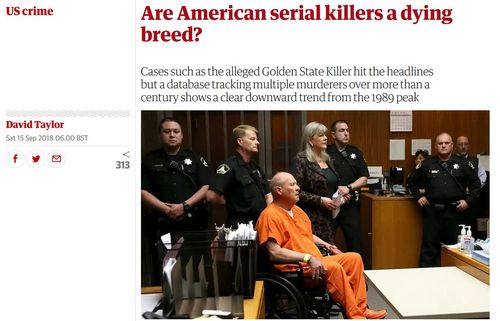
06/03/2019

This table is from Radford U.’s database on serial killers. The 2010s were only halfway done when this was compiled. Plus, who knows how long it takes to notice all the serial killers?
But it fits in with my general impression, and that of Bill James: Serial killers as a cultural phenomenon were a Sixties thing.
From The Guardian:
The best database of serial killers was developed by Mike Aamodt, emeritus professor at Radford University in Virginia. He agrees there has been a clear downward trend, but urges caution.
“There’s no question that there has been in a decline since the 80s in the number of identified serial killers,” he said. “I’m careful to say there has been a decline in the number of serial killers we can identify — there could be thousands of serial killers that we don’t know about and for some reason we’re not identifying today as well as we did in the 70s, 80s and 90s. All we know for sure is there has been a decline in the number identified.”
The Radford database, maintained in collaboration with Florida Gulf State University, has identified 5,000 serial killers from 1900 to today.
Taking the definition of serial murder as the unlawful killing of two or more victims by the same offender in separate events, the data shows 1989 was the peak year in the United States with 193 separate serial killers operating.
By the end of the 20th century, that had dropped to 107. In the current decade, an average of 43 serial killers per year have been identified in the US.
Some studies suggest the surge in serial killing was a phenomenon of urban living, the “society of strangers” thesis, where cities provided both anonymity and opportunity as people were brought closer together.
Aamodt said reasons for the apparent decline in serial killing could include advances in forensic technology, tighter use of parole and more widespread caution in the way people live. All factors which suggest victims have become harder to target and criminals easier to catch.
“One of the big reasons for the decline is change in parole,” Aamodt said. “Not quite 20% of our serial killers were people who had killed, gone to prison and had been released and killed again. With the longer prison sentences and the reduction in parole, those folks are not going to be back on the streets to kill again.
“The second factor, people have changed their behaviour. Go back and think about the 1970s, we would hitchhike, we would let kids walk to the store, let ’em go play. If there was a stranded motorist you’d go and help them — we don’t do those things any more. What we call the free-range behaviours are on the decline and it’s more difficult for serial killers to find victims than it has been in the 70s and 80s.”
Forensic skills have improved too and smaller DNA samples can be viable. “There isn’t data to support this, but it may be we are catching people after a single murder, before they commit two or three,” Aamodt said.
The Radford/FGCU data debunks the serial killer stereotype of the intellectual genius always outwitting law enforcement — there is a cluster of killers with average to low intelligence, Aamodt said.
And although the perception is that most serial killers are white men, data for the past three decades shows they have been overtaken by black serial killers — a trend which appears to be partly driven by a higher proportion of so-called “organisational” serial killers who commit murder as part of a gang or criminal operation.
Retired FBI agent and profiler Mary Ellen O’Toole, who worked on some of the most infamous serial killer cases in US history, said another factor was the proliferation of security cameras. “There are so many more cameras out there now that law enforcement is able to go back to look at,” she said. Cellphone location data has also made it easier to reconstruct the movements of suspects.
Have you noticed how the cops are now releasing videos of crimes in progress that edit together shots from different cameras, like in a movie?
On April 20 LAPD Newton ofcrs stopped a car for running a stop sign, the driver fled on foot & they gave chase. A bystander then came out of nowhere & shot an ofcr at point-blank range. Fortunately, the ofcr survived this terrifying incident. Full video 🔗 https://t.co/zh9KXInqiT pic.twitter.com/WjCg4wJ9jn
— LAPD HQ (@LAPDHQ) May 24, 2019
Basically, in the future, getting away with a crime is going to be hard if the cops really want to get you, the way they wanted to get Jussie Smollett.
This is a content archive of VDARE.com, which Letitia James forced off of the Internet using lawfare.